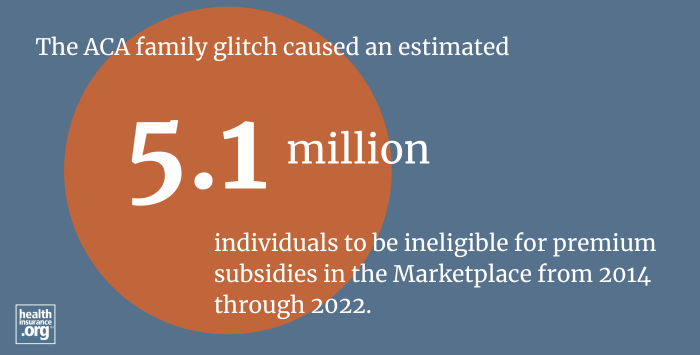
What is the family glitch?
The “family glitch” refers to the rules that were used from 2014 to 2022 to determine whether a person was eligible for a premium tax credit (subsidy) in the health insurance exchange / Marketplace if they were also eligible for employer-sponsored coverage.
Under ACA implementation rules that were issued by the IRS in 2013 and in effect through the 2022 plan year, a Marketplace subsidy was not available if the person had an offer of employer-sponsored coverage that was considered affordable and that provided minimum value. And crucially, only the cost of the employee's coverage was considered when determining whether an employer’s offer of coverage was considered affordable – regardless of whether the employee added family members to the plan or how much that would cost.
So if an employer offered reasonably-priced and fairly comprehensive coverage to employees and allowed family members to also enroll in the plan, nobody in the family was eligible for premium subsidies in the Marketplace. This was true even if the entire cost of covering the family members was payroll deducted, without any employer contributions. (Most employers do cover the majority of the cost of family coverage, but some do not, especially among smaller employers.1)
As a result of this “glitch,” an estimated 5.1 million Americans did not have access to affordable health coverage. It was too expensive for them to add family members to the employer-sponsored plan, and it was also too expensive for them to pay full price for coverage in the Marketplace.
Fortunately, the Biden administration finalized a rule change in 2022 to fix the family glitch as of the 2023 plan year. Here are the specifics of exactly what the IRS did to fix the family glitch.
The rule change allows family members to potentially access premium subsidies in the Marketplace if the cost of family coverage under the employer-sponsored plan doesn’t meet the affordability guidelines. The affordability of an employer-sponsored plans is determined separately for the employee and for the family. If the employee’s coverage is deemed affordable, the employee would not be eligible for subsidies in the Marketplace — even if the rest of their family is subsidy-eligible.
This article explains the family glitch in more detail, including the history of how it came to be and the people who were affected by it. And this article highlights some examples of how coverage affordability changed (or did not change, depending on the circumstances) under the new rules.
Footnotes
- ”Employer Health Benefits, 2024 Annual Survey” KFF. Oct. 9, 2024. ⤶


